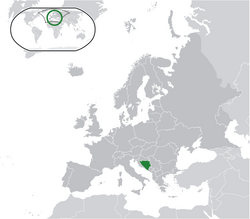Bosnia and Herzegovina ![]() bŏz'nē-ə-hěrt'sə-gō'vē-nə (help·info) (Bosnian, Croatian, Serbian Latin: Bosna i Hercegovina; Serbian Cyrillic: Босна и Херцеговина) is a country in southeastern Europe, on the Balkan Peninsula with an area of 51,129 square kilometres (19,741 sq mi). Bordered by Croatia to the north, west and south, Serbia to the east, and Montenegro to the south, Bosnia and Herzegovina is almost landlocked, except for 26 kilometres of Adriatic Sea coastline, centered on the town of Neum.[2][3] The interior of the country is mountainous in the center and south, hilly in the northwest, and flat in the northeast. Bosnia is the largest geographic region of the modern state with a moderate continental climate, marked by hot summers and cold, snowy winters. Smaller Herzegovina is at the southern tip of the country, with a Mediterranean climate and topography. Bosnia and Herzegovina's natural resources are highly abundant.
bŏz'nē-ə-hěrt'sə-gō'vē-nə (help·info) (Bosnian, Croatian, Serbian Latin: Bosna i Hercegovina; Serbian Cyrillic: Босна и Херцеговина) is a country in southeastern Europe, on the Balkan Peninsula with an area of 51,129 square kilometres (19,741 sq mi). Bordered by Croatia to the north, west and south, Serbia to the east, and Montenegro to the south, Bosnia and Herzegovina is almost landlocked, except for 26 kilometres of Adriatic Sea coastline, centered on the town of Neum.[2][3] The interior of the country is mountainous in the center and south, hilly in the northwest, and flat in the northeast. Bosnia is the largest geographic region of the modern state with a moderate continental climate, marked by hot summers and cold, snowy winters. Smaller Herzegovina is at the southern tip of the country, with a Mediterranean climate and topography. Bosnia and Herzegovina's natural resources are highly abundant.
The country is home to three ethnic "constituent peoples": Bosniaks, the most numerous population group of Bosnia, with Serbs in second and Croats in third. Regardless of ethnicity, a citizen of Bosnia and Herzegovina is often identified in English as a Bosnian. In Bosnia and Herzegovina, the distinction between a Bosnian and a Herzegovinian is maintained as a regional, rather than an ethnic distinction. The country is politically decentralized and comprises two governing entities, the Federation of Bosnia and Herzegovina and Republika Srpska, with District Brčko as a de facto third entity.
Formerly one of the six federal units constituting the Socialist Federal Republic of Yugoslavia, Bosnia and Herzegovina gained its independence during the Yugoslav wars of the 1990s. Bosnia and Herzegovina can be described as a federal democratic republic that is transforming its economy into a market-oriented system, and it is a potential candidate for membership in the European Union and NATO. Additionally, Bosnia and Herzegovina is a member of the Council of Europe since April 24, 2002 and a founding member of the Mediterranean Union upon its establishment on July 13, 2008.
Contents
[hide]- 1 History
- 2 Geography
- 3 Government and politics
- 4 Foreign relations
- 5 Demographics
- 6 Economy
- 7 Education
- 8 Culture
- 9 See also
- 10 Gallery
- 11 References
- 12 Further reading
- 13 External links
| Bosnia and Herzegovina Bosna i Hercegovina Босна и Херцеговина | ||||||
|---|---|---|---|---|---|---|
| ||||||
| Anthem: Državna himna Bosne i Hercegovine The National Anthem of Bosnia and Herzegovina | ||||||
| Location of Bosnia and Herzegovina (green) on the European continent (dark grey) — [Legend] | ||||||
| Capital (and largest city) | 43°52′N 18°25′E / 43.867°N 18.417°E | |||||
| Official languages | Bosnian, Croatian, Serbian | |||||
| Ethnic groups | 48% Bosniak 32% Serb 19% Croat[citation needed] | |||||
| Demonym | Bosnian, Herzegovinian | |||||
| Government | Federal democratic republic | |||||
| - | High Representative | Valentin Inzko1 | ||||
| - | Presidency members | Željko Komšić2 Nebojša Radmanović3 Haris Silajdžić4 | ||||
| - | Prime Minister | Nikola Špirić | ||||
| - | Constitutional Court President | Seada Palavrić | ||||
| Independence | ||||||
| - | Mentioned | 9th century | ||||
| - | Formed | August 29, 1189 | ||||
| - | Kingdom established | October 26, 1377 | ||||
| - | Independence lost to Ottoman Empire | 1463 | ||||
| - | National Day | November 25, 1943 | ||||
| - | Independence from SFR Yugoslavia | March 1, 1992 | ||||
| - | Recognized | April 6, 1992 | ||||
| Area | ||||||
| - | Total | 51,129 km2 (127th) 19,767 sq mi | ||||
| Population | ||||||
| - | 2007 estimate | 3,981,239 (126th5) | ||||
| - | 1991 census | 4,377,053 | ||||
| - | Density | 76/km2 (123rd5) 230/sq mi | ||||
| GDP (PPP) | 2008 estimate | |||||
| - | Total | $30.389 billion[1] | ||||
| - | Per capita | $7,610[1] | ||||
| GDP (nominal) | 2008 estimate | |||||
| - | Total | $18.469 billion[1] | ||||
| - | Per capita | $4,625[1] | ||||
| Gini (2007) | 26.15 (low) | |||||
| HDI (2008) | ▲ 0.802 (high) (76th) | |||||
| Currency | Convertible Mark (BAM) | |||||
| Time zone | CET (UTC+1) | |||||
| - | Summer (DST) | CEST (UTC+2) | ||||
| Drives on the | right | |||||
| Internet TLD | .ba | |||||
| Calling code | 387 | |||||














No comments:
Post a Comment